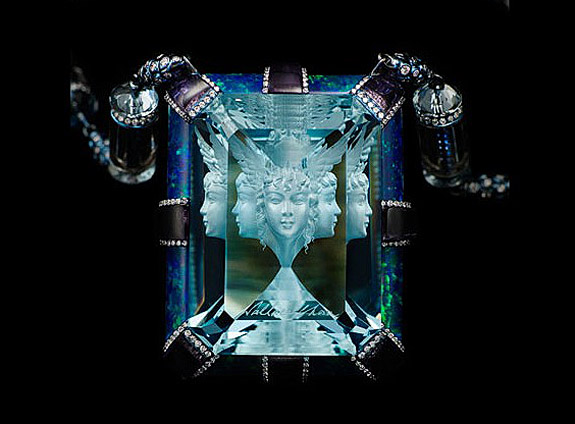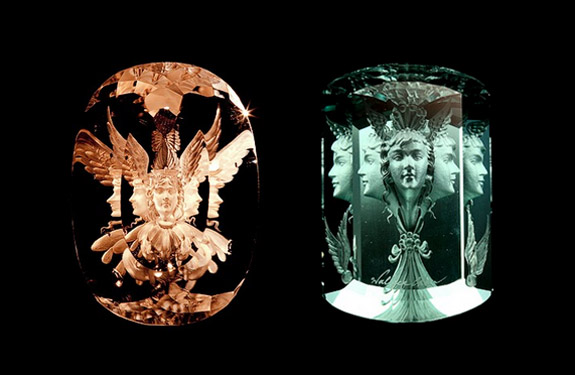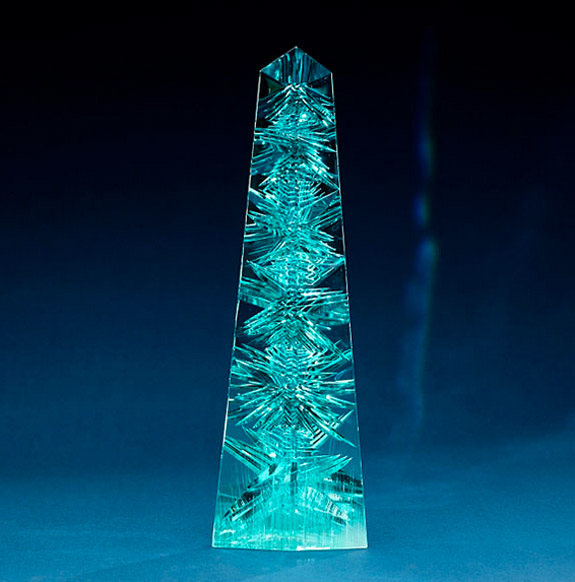July 28th, 2015
The human face you see inside this gemstone was created by master sculptor Wallace Chan, who uses a special technique — aptly named The Wallace Cut — to create a three-dimensional image that seems to be looking in several directions at once.

Using a dentist's drill with a specially adapted blade, the 59-year-old Chinese master sculptor cuts into the unfaceted back of a gemstone to render a subject that seems to be floating within the gemstone.
Working the back of the stone requires the artist to carve in reverse. Left is right, top is bottom and deep is shallow. Nevertheless, Chan has overcome this challenges with startling results. The classically trained sculptor incorporates medieval cameo and intaglio techniques in his work that is eerily lifelike and often fetches a half million dollars or more.
"Each piece can take me thousands of hours," he told CNN. "It is like going on a journey each time."

The modified dentist's drill, which spins at 36,000 times per minute, generates so much heat that the process has to take place under cold water or else the stone could be easily damaged.
"It means I can't see clearly when I'm cutting," Chan told CNN. "It becomes a very repetitive process. I make one cut, take it out of the water to check it, dry the stone, check it again, and if it's fine I put it back in the water and make another cut."

"It is a sacred thing to create a face," Chan told CNN. "It's like a ghost appearing in the gem as you work. The dialogue of gemstone, color and light gives it life. There is a Buddhist saying that every person has many selves, and that inspired me spiritually as I created this work."
Chan invented the "Wallace Cut" carving style in the mid-1980s, when he progressed from traditional carving techniques to one that incorporated the power of his modified dentist's drill.
Chan's technique of carving a gemstone from the back side is the same strategy used by Idar-Oberstein-based master cutter Bernd Munsteiner. Called “The Picasso of Gems” and “The Father of the Fantasy Cut,” Munsteiner became world famous for carving a pattern of “negative cuts” into the back of a gem, which reflects the light from within.

A beautiful example of Munsteiner's technique is seen in the obelisk-shaped “Dom Pedro” aquamarine. Munsteiner spent four months studying a 57-pound rough aquamarine crystal before embarking on a grueling six-month adventure to meticulously cut, facet and polish the stone.
Carved in 1992, "Dom Pedro" stands nearly 14 inches tall and weighs 1,363 carats. In December of 2012, the fabulous piece was donated to the Smithsonian's National Gem and Mineral Collection and is now a top attraction at the Janet Annenberg Hooker Hall of Geology.
Credits: Wallace Chan jewelry courtesy of Wallace Chan. Dom Pedro photo by Donald E. Hurlbert, Smithsonian National Museum of Natural History.

Using a dentist's drill with a specially adapted blade, the 59-year-old Chinese master sculptor cuts into the unfaceted back of a gemstone to render a subject that seems to be floating within the gemstone.
Working the back of the stone requires the artist to carve in reverse. Left is right, top is bottom and deep is shallow. Nevertheless, Chan has overcome this challenges with startling results. The classically trained sculptor incorporates medieval cameo and intaglio techniques in his work that is eerily lifelike and often fetches a half million dollars or more.
"Each piece can take me thousands of hours," he told CNN. "It is like going on a journey each time."

The modified dentist's drill, which spins at 36,000 times per minute, generates so much heat that the process has to take place under cold water or else the stone could be easily damaged.
"It means I can't see clearly when I'm cutting," Chan told CNN. "It becomes a very repetitive process. I make one cut, take it out of the water to check it, dry the stone, check it again, and if it's fine I put it back in the water and make another cut."

"It is a sacred thing to create a face," Chan told CNN. "It's like a ghost appearing in the gem as you work. The dialogue of gemstone, color and light gives it life. There is a Buddhist saying that every person has many selves, and that inspired me spiritually as I created this work."
Chan invented the "Wallace Cut" carving style in the mid-1980s, when he progressed from traditional carving techniques to one that incorporated the power of his modified dentist's drill.
Chan's technique of carving a gemstone from the back side is the same strategy used by Idar-Oberstein-based master cutter Bernd Munsteiner. Called “The Picasso of Gems” and “The Father of the Fantasy Cut,” Munsteiner became world famous for carving a pattern of “negative cuts” into the back of a gem, which reflects the light from within.

A beautiful example of Munsteiner's technique is seen in the obelisk-shaped “Dom Pedro” aquamarine. Munsteiner spent four months studying a 57-pound rough aquamarine crystal before embarking on a grueling six-month adventure to meticulously cut, facet and polish the stone.
Carved in 1992, "Dom Pedro" stands nearly 14 inches tall and weighs 1,363 carats. In December of 2012, the fabulous piece was donated to the Smithsonian's National Gem and Mineral Collection and is now a top attraction at the Janet Annenberg Hooker Hall of Geology.
Credits: Wallace Chan jewelry courtesy of Wallace Chan. Dom Pedro photo by Donald E. Hurlbert, Smithsonian National Museum of Natural History.



